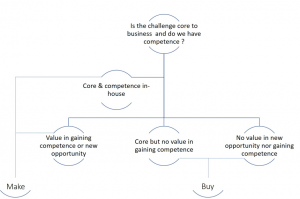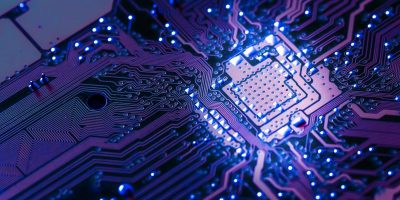A guide to developing electronic based systems – Part 2
Part 2 – To make or to buy
Assembling components from sub-components and then combining these into the whole leads to the creation of a new electronics based system; and to achieve this a diverse set of multi-disciplinary skills are required. Difficulties can arise therefore if skills are not readily available or if the skill levels are not developed to the extent needed. This article looks at the options available to companies when planning the strategy for New Product Development (NPD) and in particular whether it is better to acquire or to make the components required for the job.
To set the scene for this article, we provide three definitions.
Strategy: A plan of action, involving the use of resources, to achieve a specific aim.
Competence: The ability to deal with a matter effectively; adequate resource.
Core: The central and important part. The elements of the business that provide the main focus for creating value.
When considering strategy for product development many things need to be considered; not least the economics. One difficult question to answer is, ‘Can the desired outcomes be achieved cost effectively?’ A company may have resources to hand but will they be adequate for the task? Furthermore will the strategy create value for the company? I have not provided a definition of value here; that is left for the 7th paper which specifically covers creating value; but the point being made is that there needs to be a net positive reward from the activities undertaken. One way to consider the question is through looking at the overall challenge posed by the development. Some parts may be plain sailing but others can pose obstacles that are akin to Mount Everest.
Assessing the scale of the challenge and identifying where the value lies is a good starting point when considering optimal strategy for electronic product design.

Many tools exist to help companies set, follow and maintain strategy. One tool that can be helpful when setting strategy is a decision tree. Figure 1 provides an example of an assessment of competence and core functions. Two outcomes are listed; Make or Buy; and the decision is based on value and competency. Development of a product that will take the company down a new road is great if that path is aligned to corporate strategy but can be distracting if not; even if the development is necessary to support the current operations. Each situation will be different but the starting point is the same; the assessment of the challenge within the context of the business.
In assessing the challenge, the question of whether or not the development utilisies or develops core competencies will arise .If for example a white goods manufacturer is considering developing controls for a fridge, the answer may be yes. However if say that company finds it needs specialist software to develop wireless technology to connect to the internet the answer may be no. he answer to the question relies on understanding what the cost of owning and maintaining the relevant competencies would be in comparison to the value that is achieved. Could that same value, or better still, more value be achieved if instead the technology were bought in.
Outsourcing design activities such as PCB layout and software development can prove to be a good strategy for product development. However costs associated with management of outsourcing and integrating outsourced components should not be underestimated. But neither should the value obtainable from experts hired to do a specific job. Similarly the value of new competence gained in-house and the opportunities that may bring should also not be forgotten.

Managers setting strategy face interesting dilemmas. Addressing any new challenge involves dealing with uncertainty and the uncertainty will increase if ambiguities arise during the challenge. No matter how much time is spent on defining requirements ambiguity is difficult to avoid. The most pragmatic plans recognise the likelihood of ambiguities arising and are flexible enough to accommodate them as the engineering progresses. Options to maximise value and minimise cost should be included.
One option, where in-house competence exists, is the use of software and tools provided through open source or community projects. Electronic designs which can be used royalty free are often available as is low level software to enable engineers to get ‘up the curve’ when using specific ‘microcontrollers’ or operating systems. Care however needs to be taken as use of these offerings can result in an increase in uncertainty limiting therefore the value proposition.
A hybrid option between make and buy is the use of accelerator platforms. These can be purchased as a means of gaining momentum more securely. Synergy is one such platform but can be differentiated from others as it has been designed specifically to reduce cost-of-ownership for the customers. Proven software is provided as an integral part of the chip-set meaning that as support and warranty is available the need for in-house competence in the areas covered by the proven software is not required. The focus for the product development can then firmly be set on the core functions.
Setting strategy is not trivial. There is no magic wand but defining the competencies involved and the focus of the challenge will help when choosing the best value option between make and buy.
> How can Renesas Synergy reduce cost of ownership? More info: https://www.renesas.com/en-us/about/renesasinsite/synergy/total-cost-of-ownership.html
Whatever model is chosen perhaps the most important point is that although setting strategy is not trivial it should be set before development begins. The next article in the series looks specifically at hardware development and thereafter we tackle software.
Article series by:
Dr Val Lynch Dr. Val Lynch, CEO von AND Technology Research
Steve Norman, Manager Global Ecosystems, Renesas Electronics Europe




